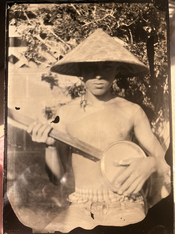Eric in Vegas
Member
I took my first tintypes today and my images all seem to come out dark (this image has also been varnished). I kept increasing exposure so I don't believe underexposure is the cause but the sun may have been outpacing my exposure adjustments. Could this be an under or over development issue?
Also, most of my images had a slight bit of fog but not over the entire image but rather like foggy artifacts. Interestingly enough, when I was cleaning some of my plates to reuse them, I found that these artifacts wiped away with a wet finger. I wouldn't think this would be good for the emulsion...has anyone encountered this, and if so, any ideas on how to prevent this?

Also, most of my images had a slight bit of fog but not over the entire image but rather like foggy artifacts. Interestingly enough, when I was cleaning some of my plates to reuse them, I found that these artifacts wiped away with a wet finger. I wouldn't think this would be good for the emulsion...has anyone encountered this, and if so, any ideas on how to prevent this?




